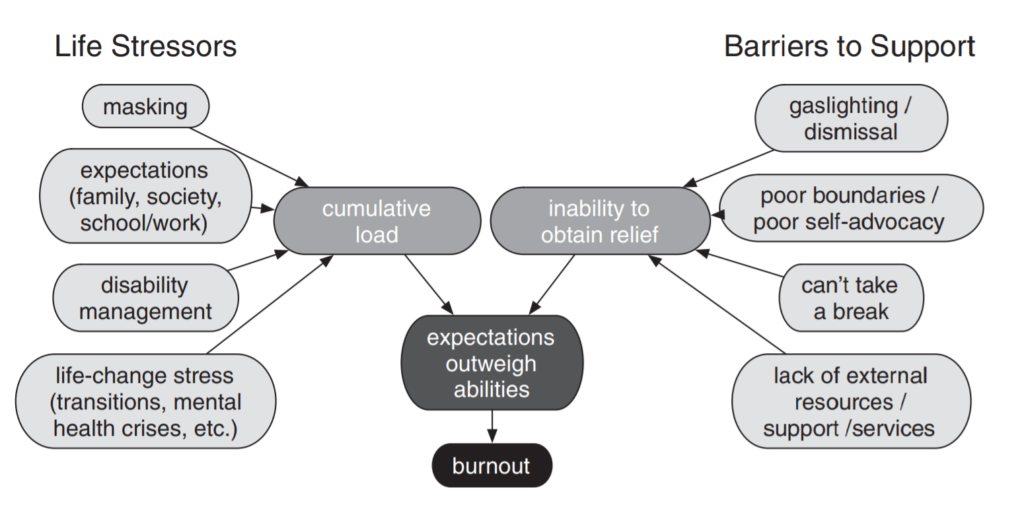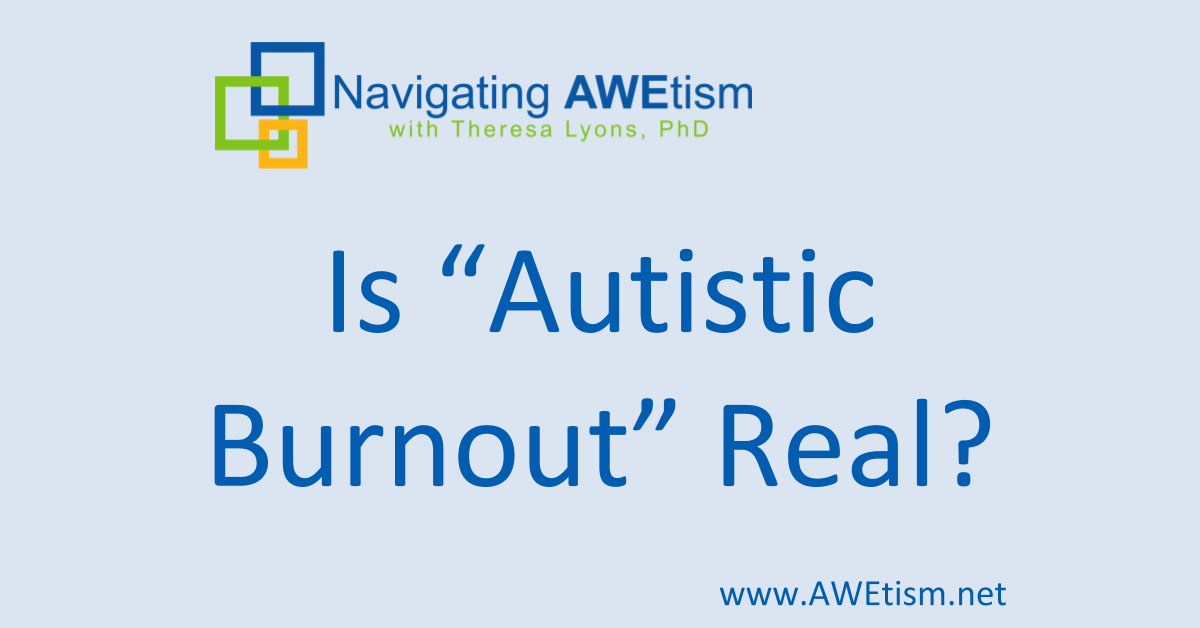Some adults with autism report that they feel chronic exhaustion, loss of skills, and reduced tolerance to stimulus. Many people with autism, they talk about it, as if it’s a burnout. And there are many people with autism who experience this.
However, it’s not formally recognized by doctors or therapists. So there’s a big disconnect between what someone with autism feels later on in life and how doctors and therapists can help them by actually recognizing this experience that they’re having.
There’s new research done to understand what autistic burnout is. This is exciting. This is new. And this is really bringing together people with autism and their experience with studying things clinically so that there can be a commonality between what someone feels and what a doctor or a therapist can do to help them.
Autism, The US & Life
Individuals with autism appear to be substantially heightened risk for death from injury. That’s in the United States. There was a study done in the year 2017, and this was really looking at the cause of death for those with autism. This study found that the mean age of death for individuals with autism was 36 years old, compared with 72 years old for the general population. In this study, it was hard to tease out high functioning versus low functioning and really drill down into the different causes of death. However, they were able to find that 28% was attributed to injury, and that’s with suffocation being the leading cause of injury and mortality followed by asphyxiation and drowning.
Another study was conducted on autism in Sweden. They wanted to really understand mortality statistics. Their findings, as well as many other studies, are finding that the life expectancy of those with autism is greatly decreased. And so this study was trying to understand high functioning versus low functioning. In this study for the high functioning group, the scientists found that one of the leading causes of mortality was suicide.
I’m going over these statistics so that when I talk about autism burnout, it’s not as if this is some made up phenomena. It’s real. And decreased mortality for those with autism is a fact. Doesn’t matter whether you’re high functioning, low functioning, male or female, it does not matter. If you have a diagnosis with autism, you have a decrease in life expectancy regardless of where in the world you live.
Why try to understand autistic burnout
Besides life mortality that we just discussed, having a shortened life is one thing, you can also then not have a very pleasurable life.
A life of chronic stress that leads to distress, problems at work and school. Your overall health is going to take a hit at your quality of life. How happy are you going to be? And even suicidal behavior, it’s a scientific fact.
Scientists wanted to better understand what high functioning adults with autism go through in life. That was really the premise that they’re trying to get at.
And I’m very happy to say that the lead author is Dr. Dora Raymaker. She has autism. She’s a researcher. She’s part of an academic group that is really trying to understand the life of someone with autism. She’s really pushing the edge of clinically what is accepted for autism. So autistic burnout is something that is really being explored by those with autism.
Methods of research
They used the community-based participatory research approach with the autistic community in all stages of the study. There are some who published this study who have autism. Obviously, there are people with autism who were in the study itself.
Those with autism were definitely participating in every step of the way. They analyzed nine interviews from their study on employment and also looked at autistic burnout and they also used Internet sources and they recruited in the U.S. by publicizing on social media, word of mouth, and also through community connections.
Results
So what did they find about autistic burnout? Here’s a quote from the actual research:
“The primary characteristics of autistic burnout were chronic exhaustion, loss of skills, and reduced tolerance to stimulus.”
I work with many people with autism, and when teenagers and their parents come to me or people in their 20’s or so, this is typically the problem to begin with. They’re just exhausted. Everything is tiring. The weekends, the weekdays, they’re not performing as well in school or work as far as they know they can, which is a source of frustration many times. And they’re just so wiped out that they’re sensitive to noise, they’re sensitive to the temperature, to light, so much of that. So this is an actual description of what many of my clients start out with. I know how real this can be.
“Participants described burnout as happening because of life stressors that added to the cumulative load they experienced, as well as barriers to support that created an inability to obtain relief from the load.”
Basically, they’re caught in a loop that is just draining them.
“These pressures caused by expectations outweigh abilities and that results in autistic burnout.”
These are the direct quotes from the results of their study.

Here’s a figure from the publication and it’s trying to explain what burnout is. You can see the black area that’s labeled burnout, that is where all of these different things are basically leading into.
So you have the life stressors and they just kind of build up so they might be masking. You may be pretending not to have autism or trying to fit in, in many different ways. There might be expectations from family, whether it’s stated or not. The person with autism might feel like there’s an expectation put on them, even if there isn’t one. There are disability management and different stress. Lots of different stress. So that’s your cumulative load.
Then there’s the inability to obtain relief. This is something I work on with my clients a lot. I always ask them how are they restoring themselves? How can they get back to who they know they really are? When life is draining them, as life does for anybody, we focus on how do they restore themselves and become who they know they really are.
So there might be gaslighting or dismissal and maybe you go to a doctor and they’re like “Oh, you’re just not handling stress.” There’s like a dismissal of what your experience is. Then the person with autism might think, “Oh, I just can’t cope. I’m not good enough.” And that’s not going to help. So that’s not obtaining relief. If someone dismisses what you’re feeling, then you’re hard on yourself even more. That just leads to burnout.
There’s also poor boundaries, poor self-advocacy. Speaking about what you need, there’s also ‘can’t take a break’ or ‘lack of external resources, support or services’. So these barriers to support, they lead to the inability to obtain relief. You combine these two things. Expectations outweigh abilities and then it all leads to burnout.
And this is the figure that the researchers have put together to explain what autistic burnout is.
The exciting thing is there is a solution to every single problem that is on this screen right now. Every single thing that is in this figure. Masking, Expectations, all of that, there is a solution.
Conclusions of Research
The conclusions of the research is a direct quote, again.
“Based on these findings and structured similarity (but with different content) to the ICD-11 definition of workplace burnout, our community-academic team created the following definition of autistic burnout:
=======
“Autistic burnout is a syndrome conceptualized as resulting from chronic life stress and a mismatch of expectations and abilities without adequate supports. It is characterized by pervasive long-term(typically 3+ months) exhaustion, loss of function, and reduced tolerance to stimulus.”
If you have a child with autism and they’re trying to explain how they just feel burnt out you can ask them about their exhaustion, the loss of function and really start to take to heart what they’re saying and I’m sure your intuition is probably telling you to believe them, please do believe them.
Next steps for this research
It is to have a larger study size. This study was very small. It’s obviously helpful, you’ve got to start somewhere, that’s how things in academia go. You start with a small study, you get some results and then you expand upon it. So the next step is obviously to have a larger study.
It also needs a control group. There was no control group in this study.
And the group of people with autism that they used to get these results was not very diverse and so it did not include anyone who was non-speaking. It also didn’t include anyone who couldn’t “pass”. There’s different levels of functioning and this study really focused on people who could “pass as a neotropical” and there’s quite a bit else that could be included to have a diverse group of people with autism to be represented in this kind of study.
Conclusion
Conclusions from the work that I do with different parents and children is autism burnout does not have to be experienced long term. Many of my clients, when they’re teenagers or young adults, they’re experiencing autism burnout and they get really frustrated because it seems as if no one really believes them. They’re not just depressed they’re not just overwhelmed with school there’s a very specific set of experiences that they’re having that just contributes to this kind of exhaustion.
Healing from autism is possible. You can help your child live a longer life. It’s totally possible. I absolutely love doing this. I have had clients whose children were suicidal, who were under the care of a therapist after suicide attempts! And goodness, life can be so different. It really can be.
The best first step in healing autism is making sure your child’s diet is nourishing them and that they are getting quality sleep. These are usually the first two steps that I start doing with a client who has autism burnout. Many times this is the best first step, not always, but if you’re eating good foods and getting nourished and you’re also getting sleep that means you can tolerate so much more in life. And it’s the first few steps to take, there’s many different things to do, but I want to give you at least a clear step in the directions to go forward, so that autism burnout doesn’t have to be something your child has for the long term.




